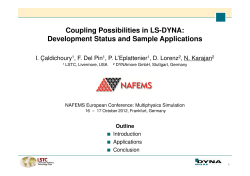
Software Reengineering P3: OO Design Principles and Violations Martin Pinzger
Software Reengineering
P3: OO Design Principles
and Violations
Martin Pinzger
Delft University of Technology
Slides adapted from the presentation by Steve Zhang
Outline
Design Smells
Object-Oriented Design Principles
Conclusions
2
The Reengineering Life-Cycle
(1) requirement
analysis
(3) problem
detection
New
Requirements
(4) problem
resolution
Designs
(2) model
capture
Code
3
Design Smells
The Odors of Rotting Software
Rigidity – The design is hard to change
Fragility – The design is easy to break
Immobility – The design is hard to reuse
Viscosity – It is hard to do the right thing
Needless complexity – Overdesign
Needless Repetition – Copy/paste
Opacity – Disorganized expression
4
The Broken Window Theory
A broken window will
trigger a building into a
smashed and abandoned
derelict
So does the software
Don’t live with the broken
window
5
S.O.L.I.D. Design Principles
S.O.L.I.D Design Principles
SRP – The Single Responsibility Principle
OCP – The Open-Closed Principle
LSP – The Liskov Substitution Principle
ISP – The Interface Segregation Principle
DIP – The Dependency Inversion Principle
7
SRP: The Single-Responsibility Principle
A class should have a single purpose and only one reason to
change
If a class has more than one responsibility, then the responsibilities
becomes coupled
SRP is one of the simplest of the principles, and the one of the
hardest to get right
8
SRP heuristics
Describe the primary responsibility in a single sentence
Group similar methods
Look at hidden methods (private, protected)
Many of them indicate that there is another class in the class tying to get
out
Look for decisions that can change (not “if-statements”)
They should go into separated classes
Look for internal relationships
Are certain variables used by some methods and not others?
9
Exercise: SRP
RuleParser
- current: String
- variables: HashMap
- currentPosition: int
+ evaluate(String rule) : int
- branchingExpression(Node left, Node right) : int
- causualExpression(Node left, Node right) : int
- variableExpression(Node node) : int
- valueExpression(Node node) : int
- nextTerm() : String
- hasMoreTerms() : boolean
+ addVariable(String name, int value)
10
Example: SRP (possible) solution
TermTokenizer
+ nextTerm() : String
+ hasMoreTerms() : boolean
RuleEvaluator
+ evaluate(String rule)
+ addVariables(String, int)
RuleParser
+ parse(String rule) : Expression
creates
SymbolTable
+ addVariable(String, int)
{abstract}
Expression
+ evaluateWith(SymbolTable table)
11
OCP: The Open-Closed Principle
Software entities( classes, modules, functions, etc.) should be
open for extension, but closed for modification
“Open for extension”
The behavior of the module can be extended (e.g., by subclassing)
“Closed for modification”
Extending the behavior of a module does not result in changes to the existing source code
or binary code of the module
12
Example: OCP – Strategy Pattern
OCP cannot be fully achieved
E.g.,
13
OCP heuristics
Look for duplicated code
Look at the change history
Classes that frequently change together
Apply potential change scenarios
Which classes would be affected by the change?
14
LSP: Liskov Substitution Principle
Subtypes must be substitutable for their base types
LSP defines the OO inheritance principle
If a client uses a base class, then it should not differentiate the base class
from derived class
In terms of design by contract
Precondition equal or weaker
Must accept anything the base class could accept
Postcondition equal or stronger
Must not violate the post-condition of the base class
15
LSP violation example
public enum ShapeType {square, circle};
public class Shape {
Violate OCP
public static void DrawShape(Shape s) {
if(s.type == ShapeType.square)
(s as Square).Draw();
else if(s.type == ShapeType.circle)
(s as Circle).Draw();
Not
substitutable
}
}
public class Circle : Shape {
public void Draw() {/* draws the circle */}
}
public class Square : Shape{
public void Draw() {/* draws the square */}
}
16
Another LSP violation example
void g(Rectangle r)
Square is not
{
Rectangle!
r.setWidth(5);
r.setHeight(4);
if(r.getArea() != 20)
throw new Exception("Bad area!");
}
IS-A Relationship
Square’s behavior is
changed, so it is not
substitutable to
Rectangle
17
LSP heuristics
Check the contracts of base and sub classes
Every LSP violation is a violation of OCP but not vice versa
18
DIP: The Dependency Inversion Principle
High-level modules should not depend on low-level modules
Both should depend on abstractions
Abstractions should not depend on details
Details should depend on abstractions
DIP is at the very heart of framework design
19
A DIP example
DIP
DIP violation
20
DIP heuristics
Depend on abstractions
No variable should hold a reference to a concrete class
No class should derive from a concrete class
No method should override an implemented method of any of its base
classes
Heuristic is typically violated at least once
Somebody has to create the instances of the concrete classes
-> No reason to strictly follow this heuristic for classes that are concrete
but non-volatile
21
ISP: The Interface Segregation Principle
Clients should not be forced to depend on methods they do
not use
Design cohesive interfaces and avoid "fat" interfaces
The dependency of one class to another one should depend on the
smallest possible interface
The interfaces of the class can be broken up into groups of methods
Each group serves a different set of clients
22
An violation of ISP example
ISP violation
23
An ISP Violation example: solution
Segregated
interface
24
ISP heuristics
Check classes with a high number of public methods
Group clients according to their calls of the public methods
Check for methods that frequently change together
25
LoD - Law of Demeter
Principle of Least Knowledge
Only talk to your immediate friends
Don’t talk to strangers
Write “shy” codes
Minimize coupling
26
LoD formal definition
A method M of an object O may only invoke the methods of
the following kinds of objects
O itself
M's parameters
Any objects created/instantiated within M
O's direct component objects
27
Example LoD
class Demeter {
public A a;
public int func() {
// do something
}
public void example(Arg arg) {
C c = new C();
int f = func();
// functions belonging to itself
arg.invert();
// to passed parameters
a = new A();
a.setActive();
// to any objects it has created
c.print();
// to any held objects
}
}
28
LoD violation example
final String outputDir = ctxt.getOptions().getScratchDir().getAbsolutePath();
a.getB().getC().doSomething()
29
DRY – Don’t Repeat Yourself
Every piece of knowledge must have a single, unambiguous,
authoritative representation within a system
Following DRY will make software systems easier to
understand and maintain
30
More information on Design Principles
Agile Software Development: Principles Patterns, and Practices
Robert C. Martin, Prentice Hall, 2002
31
Intensive Coupling(120), Shotgun Surgery(133)
Classification Disharmonies (Chapter 7): Refused Parent Bequest(145),
Tradition Breaker(152)
Design Disharmonies
32
Collaboration
Disharmonies
Collaboration Disharmonies
Limit collaboration intensity
Operations should collaborate (mainly unidirectional) with a limited
number of services provided by other classes
Limit collaboration extent
Operations (and consequently their classes) should collaborate with
operations from a limited number of other classes
Limit collaboration dispersion
An entity should collaborate closely only with a selected set of entities,
preferable located in the
same abstraction
same hierarchy
same package (or sub- system)
34
provider classes is excessively verbose. Therefore, we named this design disharmony Intensive Coupling.
Intensive Coupling
Fig. 6.2. Illustration of Intensive Coupling
35
6.3 Intensive Coupling
12
The detection strategy is based on two main conditions that mus
be fulfilled simultaneously: the function invokes many methods an
the invoked methods are not very much dispersed into many classe
(Fig. 6.3).
Additionally, based on our practical experience, we impose a min
imal complexity condition on the function, to avoid the case of config
uration operations (e.g., initializers, or UI configuring methods) tha
call many other methods. These configuration operations reveal a les
harmful (and hardly avoidable) form of coupling because the depen
dencies can be much easily traced and solved.
The detection strategy is composed of the following heuristics (se
Fig. 6.3):
Intensive Coupling: Detection Strategy
22
6 Collaboration Disharmonies
Operation calls too many
methods
CINT > Short Memory Cap
AND
Class are "dispersed" in
few classes
CDISP < HALF
OR
and unrelated classes
Operation calls more than
a few methods
AND
Method has few nested
conditionals
CINT > FEW
AND
Calls are "dispersed" in
very few classes
CDISP < A QUARTER
Operation
calls methods
too
Method
calls too many
from
manyfew
methods
few
unrelatedfrom
classes
Intensive
Coupling
MAXNESTING > SHALLOW
Fig. 6.3. Intensive Coupling detection strategy.
1. Operation calls too many methods from a few unrelated classe
Fig. 6.4. In Intensive Coupling operation calls too many
from a for
fewa method or function to be considered a
Themethods
basic condition
unrelated classes
having an Intensive Coupling is to call many methods belongin
to a few classes (Fig. 6.4). By “unrelated classes” we mean tha
36
the provider classes are belonging to the the same class hierarch
Intensive Coupling: Example
124
6 Collaboration Disharmonies
37
Intensive Coupling: Class Blueprint
6.3 Intensive Coupling
125
Fig. 6.6. The class ClassDiagramLayouter is intensively coupling with a few
classes, especially ClassDiagramNode.
38
ch class.
Dispersed Coupling
39
conditionals
MAXNESTING > SHALLOW
Dispersed Coupling: Detection Strategy
128
6 Collaboration
Disharmonies
Fig. 6.9. Dispersed Coupling detection
strategy
Detection
The detection rule is defined in the same terms as the the one define
for Intensive Coupling(120), with only one complementary differenc
we capture only those operations that have a high dispersion of the
coupling (Fig. 6.9). The detection strategy in detail is:
Operation calls too many
methods
CINT > Short Memory Cap
AND
Calls are dispersed in
many classes
CDISP HALF
Operation calls a few methods from
each
of a largecalls
number
Operation
a few
of unrelated
methods
from classes
each of a large
number of unrelated classes
AND
Operation has few nested
conditionals
Dispersed
Coupling
MAXNESTING > SHALLOW
ig. 6.10. In Dispersed Coupling operation calls a few methods from each of
Fig. 6.9. Dispersed Coupling detection strategy
large number of unrelated classes.
. Operation calls a few methods from each of a large number
of unrelated classes. This term of the Operation
detection
rules
calls too
many imposes
two conditions: an intensive coupling, i.e., the methods
invocation of many
methods from other classes (CINT - Coupling
Intensity),
CINT > Short
Memory Cap and a
large dispersion among classes of these invoked operations (CDISP
AND
Operation calls a few
40
methods from each of a lar
should have a non-trivial nesting level, to make sure that irrelevant cases (like initializer functions) are skipped.
Dispersed Coupling: Example
41
pling strength but also the coupling dispersion.
Shotgun Surgery
42
dependencies caused by function calls. In order to reveal especially
those cases where dependencies are harder to trace, we will count
Shotgun
Surgery:
Detection
Strategy
only those operations
(and classes)
that are neither
belonging to the
same class nor to the same class hierarchy with the measured operation.
Operation is called by too many
other methods
CM > Short Memory Cap
AND
Shotgun Surgery
Incoming calls are from
many classes
CC > MANY
Fig. 6.14. Shotgun Surgery detection strategy
Based on all the considerations above, the detection technique is
43
detected.
Shotgun Surgery: Example
Fig. 6.15. Project provides an impressive example of a class with several
methods affected by Shotgun Surgery(133). Due to these methods, Project is
coupled with 131 classes (ModelFacade has been elided from the screenshot). Furthermore, the class has cyclic invocation dependencies with Pro-44
Tool to Detect Collaboration Disharmonies
inCode
http://loose.upt.ro/incode/pmwiki.php/
45
More info on Detection Strategies
Object-Oriented Metrics in Practice
Michele Lanza and Radu Marinescu, Springer 2006
http://www.springer.com/computer/swe/book/
978-3-540-24429-5
46
Summary
The OO design principles help us:
As guidelines when designing flexible, maintainable and reusable
software
As standards when identifying the bad design
As laws to argue when doing code review
Keep the design of a system as simple, clean, and expressive as
possible
Don’t allow broken windows
Apply them in iterations (not to a big, up-front design)
Sometimes you have to make trade-offs
47
© Copyright 2025





















